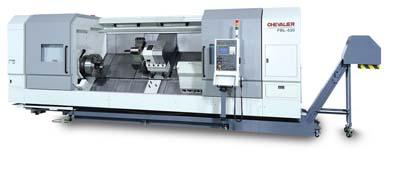
Chevalier's FBL-530 is a versatile machine that is helping manufacturers with a wide range of needs. The slant bed lathes are stable, highly accurate machines that can handle rough- and fine-turning operations for large workpieces. Its structure, capacity, power and accessories underscore the machine's ability to expertly and ruggedly handle various operations in an efficient, productive manner.
"The FANUC 0i-TD control with FANUC digital servo drive and motor are standard features with the FBL-530," says Chevalier National Sales Manager Herbert Hou. "That represents a substantial cost savings for our customers. Other control companies sell these features as options."
STRUCTURE: Heat treated to Rockwell 55 degree and stress relieved. Features a 45 degree slant-bed design, comprised of single-piece Meehanite cast iron with wide-span, ribbed box structure. Four oversized box ways, 130-mm wide and 80-mm high, provide strong stability and support.
CAPACITY: Spindle bore diameter ranges in size up to 12.5", which suits most oil industry applications. Maximum swing diameter is 40.5"; cutting diameter is 37". Three sizes offered: 80", 120" and 160". Special Z-axis, ball screw support maintains high precision and stability. Dual-chuck, easy access design provides convenience of loading and unloading longer parts.
POWER: Powerful 60 HP Spindle motor that features a four-stage gearbox and generates 7,118 NM torque would satisfy most cutting condition of large-diameter work pieces or tough material applications.
TURRET: Massive, 200-mm-thick disk and hydraulic clamping of its curvic-coupling design ensure cutting stability during rough turning environments.
ACCESSORIES: Standard equipment of programmable tailstock has a built-in MT-6 rotary quill that provides better part's weight support than a normal live-center type of quill. Standard link-type chip conveyor is also a standard accessory.
Contact Details
Related Glossary Terms
- turning
turning
Workpiece is held in a chuck, mounted on a face plate or secured between centers and rotated while a cutting tool, normally a single-point tool, is fed into it along its periphery or across its end or face. Takes the form of straight turning (cutting along the periphery of the workpiece); taper turning (creating a taper); step turning (turning different-size diameters on the same work); chamfering (beveling an edge or shoulder); facing (cutting on an end); turning threads (usually external but can be internal); roughing (high-volume metal removal); and finishing (final light cuts). Performed on lathes, turning centers, chucking machines, automatic screw machines and similar machines.

